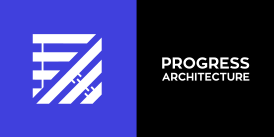
PROGRESS ARCHITECTURE has the widest range of products on the market today. It allows flexible customisation of solutions to meet design and budget parameters. The offer includes woven mesh made of round, flat, crimped wires and cables, perforated and expanded metal, and welded grids made of round and profile wires. Products are available in a variety of designs, materials and finishes, primarily stainless steel, black steel, Pro-ZINAL®, copper and aluminium.
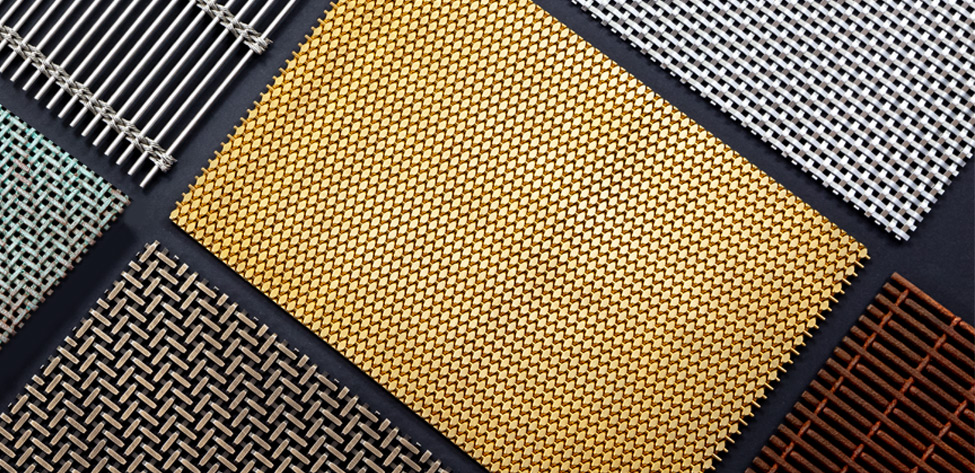
PROGRESS ARCHITECTURE’s woven wire mesh is not only a practical solution, but also an aesthetic element that attracts attention with its variety of patterns and textures. The ability to customise the pattern, spacing and material allows the creation of unique architectural designs that can be used for building facades, suspended ceilings, interior decoration and garden elements.
Name AQUARIUS P10011
Open area 44,6 %
Weight 7,2-7,3 kg/m2
Width (max) 3000mm
Thickness 4,5 mm
Mesh 31,0 x 2,0 mm
Materials Stainless steel
Name AQUARIUS P10020
Open area 66,1%
Weight 2,2-7,3 kg/m2
Width (max) 3000mm
Thickness 6,8 mm
Mesh 74,0 x 7,5mm
Materials Stainless steel Galvanized steel Aluminum Copper Brass Bronze
Name AQUARIUS P10021
Open area 64%
Weight 2,5-8,2 kg/m2
Width (max) 3000mm
Thickness 7,5mm
Mesh 67,5 x 7,4mm
Materials Stainless steel Galvanized steel Aluminum Copper Brass Bronze
Name ARIES OL P01415
Open area 41,4%
Weight 10,9-12,3 kg/m2
Width (max) 4000mm
Thickness 3mm
Mesh 4,15 x 4,15mm
Materials Stainless steel Copper Brass Bronze
Name ARIES P01035
Open area 69,4%
Weight 2,7-8,3 kg/m2
Width (max) 3000mm
Thickness 6 mm
Mesh 15,0 x 15,0mm
Materials Stainless steel Galvanized steel Aluminum Copper Brass Bronze
Name ARIES TL P01047
Open area 80,2%
Weight 1,7-5,4kg/m2
Width (max) 3000mm
Thickness 5,5mm
Mesh 30,0 x 30,0mm
Materials Stainless steel Galvanized steel Aluminum Copper Brass Bronze
Name ARRAS D08100
Crossbar 8,4 x 2 mm
Tq 100
Open area 54%
Slot 10mm
Weight 8,6 kg/m2
Dimensions (max) 2500//3000 mm
Materials Carbon steel
Name ARRAS D08160
Crossbar 8,4 x 2 mm
Tq 100
Open area 65%
Slot 16mm
Weight 6,8 kg/m2
Width (max) 2500//3000 mm
Materials Carbon steel
Name EGIDA P14035
Open area 0 %
Weight 21,6-24,3 kg/m2
Width (max) 3000mm
Thickness 4 mm
Mesh 0,0 x 3,5mm
Materials Stainless steel Galvanized steel Copper Brass Bronze
Name LEO P06030
Open area 45,6%
Weight 2,6-8,3 kg/m2
Width (max) 4000mm
Thickness 4,5mm
Mesh 2,0 x 15,5mm
Materials Stainless steel Galvanized steel Aluminum Copper Brass Bronze
Name LEO P06040
Open area 52,1%
Weight 6,9-7,0 kg/m2
Width (max) 4000mm
Thickness 4,8 mm
Mesh 2,5 x 30,0mm
Materials Stainless steel Galvanized steel
Name LEO P06051
Open area 49,9 %
Weight 3,3-10,8 kg/m2
Width (max) 4000mm
Thickness 5,5 mm
Mesh 25,0 x 3,5mm
Materials Stainless steel Galvanized steel Aluminum Copper Brass Bronze
Name LEO P06075
Open area 70,9%
Weight 1,3-4,4 kg/m2
Width (max) 4000mm
Thickness 4,5mm
Mesh 7,0 x 15,5mm
Materials Stainless steel Galvanized steel Aluminum Copper Brass Bronze
Name LEO P06090
Open area 50,6%
Weight 2,0-6,7 kg/m2
Width (max) 4000mm
Thickness 4 mm
Mesh 2,0 x 15,5mm
Materials Stainless steel Aluminum Galvanized steel Copper Brass Bronze
Name ORION P17030
Open area 25 %
Weight 8,7-8,8 kg/m2
Width (max) 3000mm
Thickness 3,5 mm
Mesh 3,0 x 3,0mm
Materials Stainless steel Galvanized steel
Name SAGITTARIUS P11320
Open area 66,1%
Weight 6,1-6,2 kg/m2
Width (max) 4000 mm
Thickness 7,15mm
Wariant mocowania Rod , Comb , Flat Bar
Mesh 7,5 x 74,0mm
Materials Stainless steel
Name SAGITTARIUS P11432
Open area 53,3%
Weight 5,6 kg/m2
Width (max) 4000 mm
Thickness 4mm
Mesh 3,0 x 32,0mm
Materials Stainless steel
Name SAGITTARIUS P11440
Open area 56,2%
Weight 7,8-7,9 kg/m2
Width (max) 4000 mm
Thickness 7,15mm
Mesh 5,0 x 71,0 mm
Materials Stainless steel
Name SATURN P05130
Open area 50,6%
Weight 5,2 kg/m2
Width (max) 4000mm
Thickness 4,5 mm
Mesh 2,0 x 15,5mm
Materials Stainless steel
Name SATURN P05131
Open area 64,4%
Weight 3,7 kg/m2
Width (max) 4000 mm
Thickness 4,5mm
Mesh 4,0 x 15,5mm
Materials Stainless steel
Name SATURN P05136
Open area 70,9%
Weight 2,9-3,0 kg/m2
Width (max) 4000mm
Thickness 4,5mm
Mesh 6,0 x 15,5mm
Materials Stainless steel
Name SATURN P05140
Open area 46,6%
Weight 6,7-6,8 kg/m2
Width (max) 4000mm
Thickness 5mm
Mesh 2,0 x 15,5mm
Materials Stainless steel
Name SCORPIO P04010
Open area 80 %
Weight 3,8 kg/m2
Width (max) 4000 mm
Thickness 6 mm
Mesh 18,0 x 84,0mm
Materials Stainless steel Galvanized steel
Name SCORPIO P04020
Open area 67,3%
Weight 8,6 x 8,7 kg/m2
Width (max) 4000 mm
Thickness 7 mm
Mesh 11,0 x 84,0mm
Materials Stainless steel Galvanized steel
Name SCORPIO P04040
Open area 67,1%
Weight 6,5 x 6,6 kg/m2
Width (max) 4000 mm
Thickness 6 mm
Mesh 7,5 x 84,0mm
Materials Stainless steel Galvanized steel
Name TAURUS P02030
Open area 63%
Weight 3,3 kg/m2
Width (max) 3000mm
Thickness 2,6mm
Mesh 2,8 x 10,8mm
Materials Stainless steel Galvanized steel
Name VIRGO P07020
Open area 43,3%
Weight 7,9-8,0 kg/m2
Width (max) 4000 mm
Thickness 3,8mm
Mesh 2,0 x 15,5 mm
Materials Stainless steel Galvanized steel
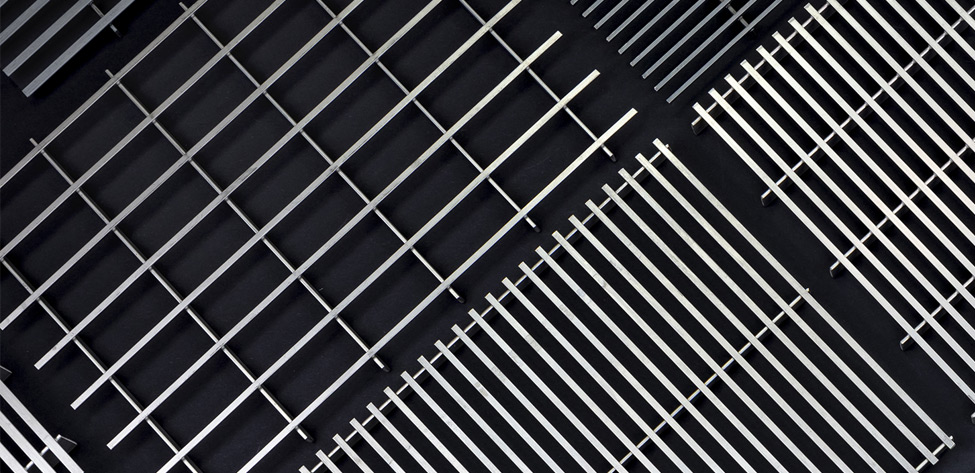
PROGRESS ARCHITECTURE’s welded grids not only offer a wide range of solutions, but also guarantee exceptional durability thanks to the precise welding process. Ideal for heavy-duty applications, they retain their aesthetic qualities and their minimalist design makes them the ideal choice for both indoor and outdoor applications, perfectly meeting a wide range of architectural requirements.
Name ARRAS D08100
Crossbar 8,4 x 2 mm
Tq 100
Open area 54%
Slot 10mm
Weight 8,6 kg/m2
Dimensions (max) 2500//3000 mm
Materials Carbon steel
Name ARRAS D08160
Crossbar 8,4 x 2 mm
Tq 100
Open area 65%
Slot 16mm
Weight 6,8 kg/m2
Width (max) 2500//3000 mm
Materials Carbon steel
Name RADIUS Z07065
Crossbar 10 x 2 mm
Tq 100 mm
Open area 65%
Slot 6,5mm
Weight 7,3 kg/m2
Dimensions (max) 2500//3000 mm
Materials Stainless steel
Name RADIUS Z07105
Crossbar 10 x 2 mm
Tq 100 mm
Open area 75%
Slot 10,5mm
Weight 6,2 kg/m2
Dimensions (max) 2500//3000 mm
Materials Stainless steel
Name RADIUS Z07115
Crossbar 10 x 2 mm
Tq 100 mm
Open area 77%
Slot 11,5mm
Weight 5,7 kg/m2
Dimensions (max) 2500//3000 mm
Materials Stainless steel
Name RADIUS Z07165
Crossbar 10 x 2 mm
Tq 100 mm
Open area 83%
Slot 16,5mm
Weight 4,8 kg/m2
Dimensions (max) 2500//3000 mm
Materials Stainless steel
Name RADIUS Z10080
Crossbar 8,4 x 2 mm
Tq 100 mm
Open area 65%
Slot 8mm
Weight 7,9 kg/m2
Dimensions (max) 2500//3000 mm
Materials Carbon steel
Name RADIUS Z10105
Crossbar 8,4 x 2 mm
Tq 100 mm
Open area 70%
Slot 10,5mm
Weight 6,9 kg/m2
Dimensions (max) 2500//3000 mm
Materials Carbon steel
Name RADIUS Z10155
Crossbar 8,4 x 2 mm
Tq 100mm
Open area 77%
Slot 15,5mm
Weight 6,1 kg/m2
Dimensions (max) 2500//3000 mm
Materials Carbon steel
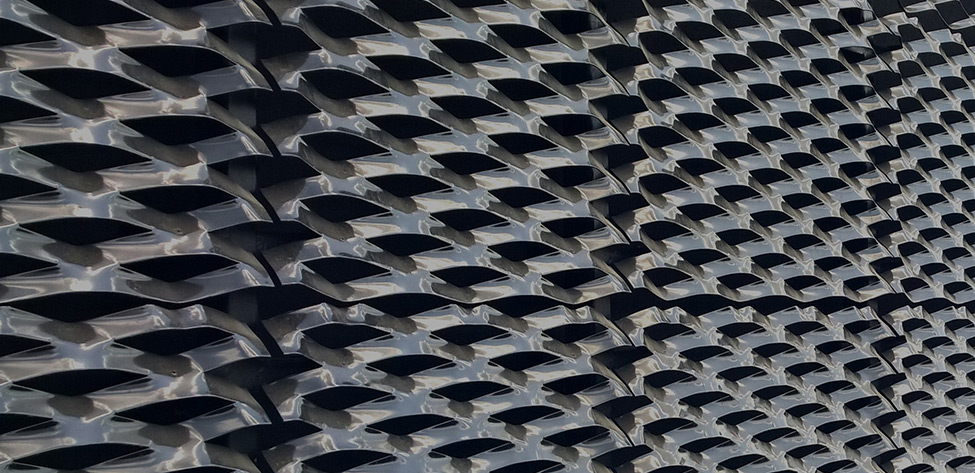
Expanded metal meshes, obtained by cutting and stretching metal sheets, are characterised by regular holes of precise dimensions and shapes, giving them durability, flexibility and resistance to deformation. They are used in industry, construction and interior design for both decorative and functional purposes, such as facade elements, balustrades and screens.
Name GALLA C025010025
Open area 51%
Short way Pitch 25mm
Long way Pitch 10mm
Strand width 2,5mm
Strand thickness 1,5mm
Materials Aluminum
Name GALLA C025015020
Open area 74 %
Short way Pitch 25mm
Long way Pitch 15mm
Strand width 2,0mm
Strand thickness 1,5mm
Materials Aluminum
Name GALLA C030013030
Open area 54 %
Short way Pitch 30,48 mm
Long way Pitch 13 mm
Strand width 3 mm
Strand thickness 1,5 mm
Materials Carbon steel
Name GALLA C030013035
Open area 47 %
Short way Pitch 30,48mm
Long way Pitch 13mm
Strand width 3,5mm
Strand thickness 1,5mm
Materials Aluminum
Name GALLA C043017025
Open area 71 %
Short way Pitch 43mm
Long way Pitch 17mm
Strand width 2,5mm
Strand thickness 1,5mm
Materials Aluminum
Name GALLA C050019030
Open area 69 %
Short way Pitch 50 mm
Long way Pitch 19 mm
Strand width 3 mm
Strand thickness 1,5 mm
Materials Carbon steel
Name GALLA C050019040
Open area 58 %
Short way Pitch 50mm
Long way Pitch 19mm
Strand width 4mm
Strand thickness 1,5mm
Materials Aluminum
Name GALLA C050029030
Open area 80 %
Short way Pitch 50mm
Long way Pitch 29mm
Strand width 3,0mm
Strand thickness 1,5mm
Materials Aluminum
Name GALLA C063025090
Open area 29 %
Short way Pitch 62,5mm
Long way Pitch 25mm
Strand width 9,0mm
Strand thickness 1,5mm
Materials Aluminum
Name GALLA C076031090
Open area 42 %
Short way Pitch 76 mm
Long way Pitch 31 mm
Strand width 9 mm
Strand thickness 1,5 mm
Materials Aluminum
Name GALLA C100035125
Open area 29 %
Short way Pitch 100 mm
Long way Pitch 35,1 mm
Strand width 12,5 mm
Strand thickness 1,5 mm
Materials Aluminum
Name GALLA C125040145
Open area 28 %
Short way Pitch 125 mm
Long way Pitch 40 mm
Strand width 14,5 mm
Strand thickness 1,5 mm
Materials Aluminum
Name GALLA C150050180
Open area 29 %
Short way Pitch 150mm
Long way Pitch 50mm
Strand width 18,00mm
Strand thickness 1,5mm
Materials Aluminum
Name GALLA C200060200
Open area 34 %
Short way Pitch 200 mm
Long way Pitch 60 mm
Strand width 20 mm
Strand thickness 1,5 mm
Materials Aluminum
Name GALLA C250080220
Open area 45 %
Short way Pitch 250 mm
Long way Pitch 80 mm
Strand width 22 mm
Strand thickness 1,5 mm
Materials Aluminum
Name GALLA C020008025
Open area 34 %
Short way Pitch 20 mm
Long way Pitch 7,5 mm
Strand width 2,5 mm
Strand thickness 1,5 mm
Materials Aluminum
PROGRESS ARCHITECTURE offers professional advice on the choice of materials and finishes, adapted to the weather conditions, intensity of use and specific features of a particular application. The analysis of alternative variants allows us to adapt the solution to the budget constraints while maintaining the design objectives. The exceptional durability of the effect is guaranteed by advanced production technologies and the use of high quality materials and special coatings.
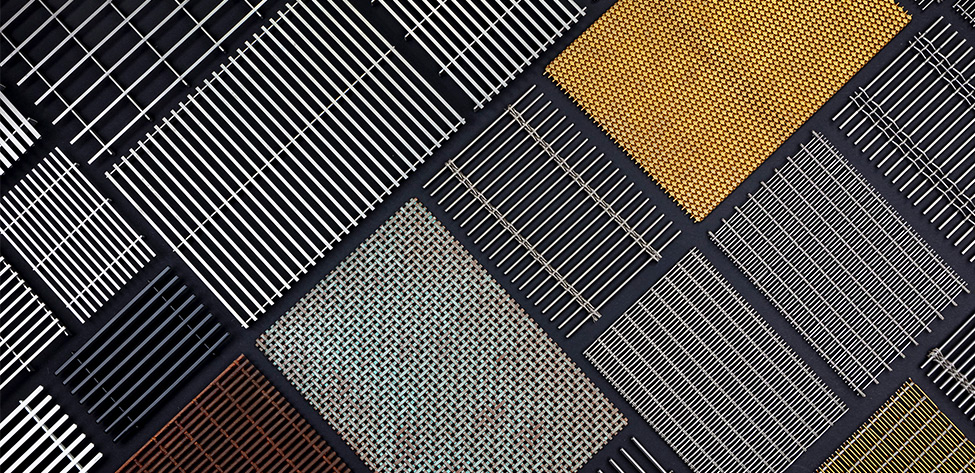
As well as being a standard building material, metal meshes and grids are an important design element, representing the highest quality architectural finish. Manufactured from high quality materials such as stainless steel, they are resistant to corrosion and wear, ensuring long-lasting performance and minimal maintenance costs. Maintenance savings not only benefit the project budget, but also contribute to its sustainability.
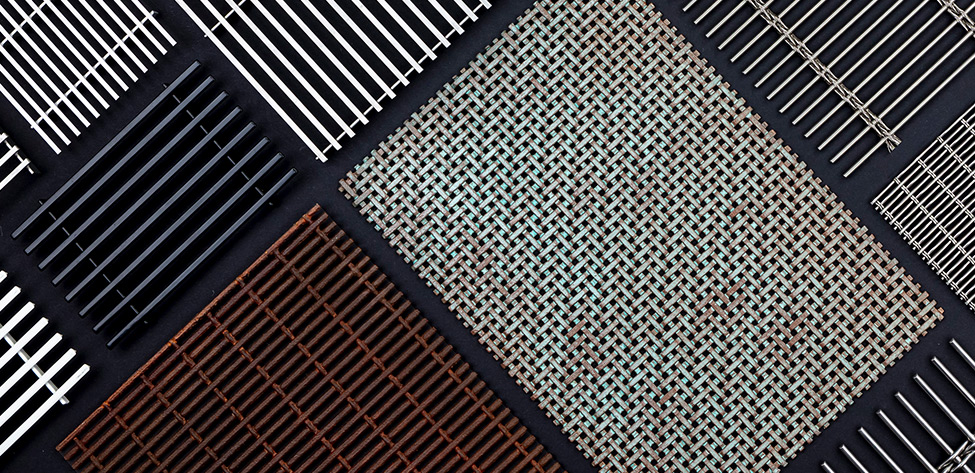
A wealth of finishing options for metal meshes and grids, such as painting, polishing, brushing or printing, allow you to transform your space into true masterpieces. These different techniques not only add aesthetic appeal, but also offer the opportunity for personalisation. They allow you to tailor meshes and grids to your unique needs and individual design concepts.
Contact our technical department who will answer any questions you may have.
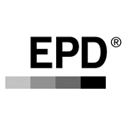
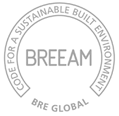
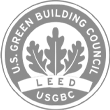
BY CHOOSING ENVIRONMENTALLY FRIENDLY PRODUCTS